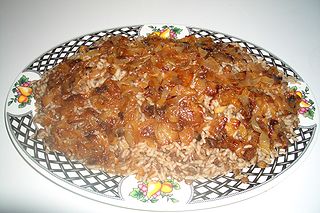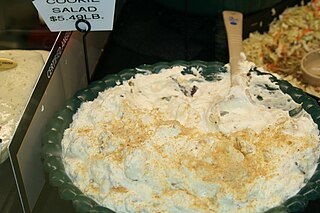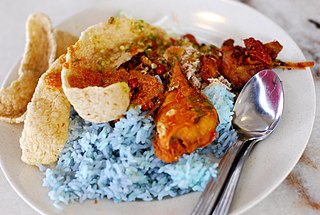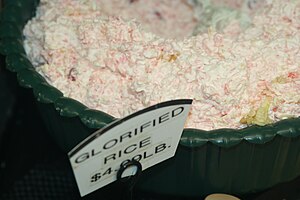
The cuisine of the American Midwest draws its culinary roots most significantly from the cuisines of Central, Northern and Eastern Europe, and Indigenous cuisine of the Americas, and is influenced by regionally and locally grown foodstuffs and cultural diversity.

Vietnamese cuisine encompasses the foods and beverages originated from Vietnam. Meals feature a combination of five fundamental tastes : sweet, salty, bitter, sour, and spicy. The distinctive nature of each dish reflects one or more elements, which are also based around a five-pronged philosophy. Vietnamese recipes use ingredients like lemongrass, ginger, mint, Vietnamese mint, long coriander, Saigon cinnamon, bird's eye chili, lime, and Thai basil leaves. Traditional Vietnamese cooking has often been characterised as using fresh ingredients, not using much dairy or oil, having interesting textures, and making use of herbs and vegetables. The cuisine is also low in sugar and is almost always naturally gluten-free, as many of the dishes are rice-based instead of wheat-based, made with rice noodles, papers and flour. Vietnamese cuisine is strongly influenced not only by the cuisines of neighboring China, Cambodia and Laos, but also by French cuisine due to French colonial rule over the region from 1887 to 1954.

Hungarian or Magyar cuisine is the cuisine characteristic of the nation of Hungary, and its primary ethnic group, the Magyars. Hungarian cuisine has been described as being the spiciest cuisine in Europe. This can largely be attributed to the use of their piquant native spice, Hungarian paprika, in many of their dishes. A mild version of the spice, Hungarian sweet paprika, is commonly used as an alternative. Traditional Hungarian dishes are primarily based on meats, seasonal vegetables, fruits, bread, and dairy products.

A hotdish or hot dish is a casserole dish that typically contains a starch, a meat, and a canned or frozen vegetable mixed with canned soup. The dish originates in the Upper Midwest region of the United States, where it remains popular, particularly in Minnesota, South Dakota, Wisconsin, North Dakota, and eastern Montana. Hotdish is cooked in a single baking dish, and served hot. It commonly appears at communal gatherings such as family reunions, potlucks, and church suppers. A classic example known as "tater tot hotdish" is made with ground beef, topped with tater tots, and flavored with thick, condensed cream of mushroom soup sauce.

Cellophane noodles, or fensi, sometimes called glass noodles, are a type of transparent noodle made from starch and water. A stabilizer such as chitosan may also be used.

Iraqi cuisine is a Middle Eastern cuisine that has its origins in the ancient Near East culture of the fertile crescent. Tablets found in ancient ruins in Iraq show recipes prepared in the temples during religious festivals—the first cookbooks in the world. Ancient Mesopotamia was home to a sophisticated and highly advanced civilization, in all fields of knowledge, including the culinary arts.

Mujaddara is a dish consisting of cooked lentils together with groats, generally rice, and garnished with sautéed onions. It is especially popular in the Levant.

Rice vermicelli is a thin form of noodle. It is sometimes referred to as "rice noodles" or "rice sticks", but should not be confused with cellophane noodles, a different Asian type of vermicelli made from mung bean starch or rice starch rather than rice grains themselves.

Gỏi cuốn, nem cuốn, salad roll, summer roll, fresh spring roll, spring roll, or rice paper roll is a Vietnamese dish traditionally consisting of pork, prawn, vegetables, bún, and other ingredients wrapped in bánh tráng. Unlike other spring roll dishes, which are believed to originate from China, Vietnamese gỏi cuốn is a national creation using bánh tráng.

Salade niçoise is a salad that originated in the French city of Nice. It is traditionally made of tomatoes, hard-boiled eggs, Niçoise olives and anchovies or tuna, dressed with olive oil, or in some historical versions, a vinaigrette. It has been popular worldwide since the early 20th century, and has been prepared and discussed by many chefs. Delia Smith called it "one of the best combinations of salad ingredients ever invented" and Gordon Ramsay said that "it must be the finest summer salad of all".
Udupi cuisine is a cuisine of South India. It forms an important part of Tuluva cuisine and takes its name from Udupi, a city on the southwest coast of India in the Tulunadu region of the state of Karnataka.

Chinese chicken salad is a salad including chopped chicken and Chinese culinary ingredients that is common in parts of the United States. Though many variations exist, common features of Chinese chicken salads include lettuce, cabbage, carrots, cucumbers, chicken, deep-fried wonton skins or rice vermicelli and nuts. A basic vinaigrette for the salad includes ingredients like vegetable oil, sesame oil, rice vinegar. Optional seasonings include dry hot mustard, sesame seeds, coriander and raw ginger or pickled ginger. In restaurants, Chinese chicken salad may be more embellished and offered as an American-style entree salad, similar to Caesar, Chef, and Cobb salads.

Ham salad is a traditional Anglo-American salad. Ham salad resembles chicken salad, egg salad, and tuna salad : the primary ingredient, ham, is mixed with smaller amounts of chopped vegetables or relishes, and the whole is bound with liberal amounts of a mayonnaise, salad cream, or other similar style of salad dressing, such as Miracle Whip.

The cuisine of Minnesota is a type of Midwestern cuisine found throughout the state of Minnesota.

Cookie salad is a dessert salad from the U.S. states of Minnesota and North Dakota made with buttermilk, vanilla pudding, whipped cream, mandarin oranges, and fudge stripe shortbread cookies. Dessert salads, like glorified rice and cookie salad, are more common in the cuisine of the Midwestern United States than other parts of the country. They are popular with children and a common contribution to holiday tables and potlucks. Berries can also be added. The salad is also prepared in other areas of the Midwestern United States.

A meatball is ground meat (mince) rolled into a ball, sometimes along with other ingredients, such as bread crumbs, minced onion, eggs, butter, and seasoning. Meatballs are cooked by frying, baking, steaming, or braising in sauce. There are many types of meatballs using different types of meats and spices. The term is sometimes extended to meatless versions based on vegetables or fish; the latter are also commonly known as fish balls.

Nasi kerabu is a Malaysian rice dish, a type of nasi ulam, in which blue-colored rice is eaten with dried fish or fried chicken, crackers, pickles and other salads. The blue color of the rice comes from the petals of Clitoria ternatea (butterfly-pea) flowers (bunga telang), which are used as a natural food coloring in cooking it. The rice can also be plain white rice or rice cooked using turmeric. It is often eaten with solok lada and is also eaten with fried keropok.
















